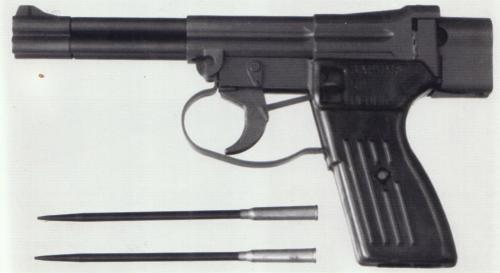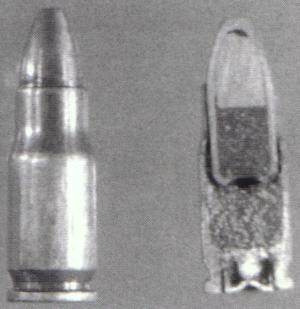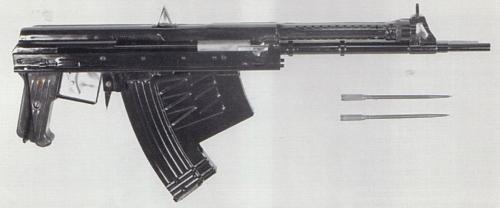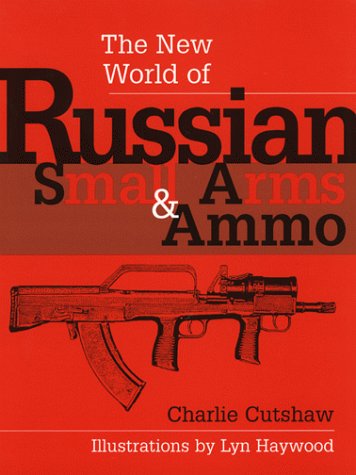Firearm Technical Trivia, November 2001 (original) (raw)
CRUFFLER.COM
presents
Firearms Technical Trivia, November 2001:
INTRODUCTION
The Russian military small arms industry has, for the last quarter century, been a fertile ground for new and innovative special purpose cartridge developments. Many of these developments are logical and lineal extensions of standard service cartridges, while others are wholly new and unique developments. This article is not intended as a comprehensive guide, but rather as a familiarization that we hope will whet your appetites for more information.
4.5x39Rmm SPS UNDERWATER PISTOL CARTRIDGE
| This highly specialized cartridge is used by the SPP-1 underwater pistol. The cartridge was designed by the team of Pyotr Sazonov and Oleg Kravchenko, who received a USSR State Prize in 1983 for their work, along with Vladimir Simonov, designer of the SPP-1 pistol. In their initial experiments, the designers found that standard bullets fired underwater had very limited range and would not work with firearms specifically designed for underwater use. The designers therefore began to look at patterning their bullets after the long darts used by divers for spear fishing. This proved to be the solution, and |  SPS Underwater Cartridge and SPP-1 Pistol SPS Underwater Cartridge and SPP-1 Pistol |
|---|
the cartridges for both the SPP- 1 pistol and APS underwater assault rifle were designed using the "dart" bullet.
The SPS cartridge fires a 203-grain (13.2-gram) steel bullet at a muzzle velocity of approximately 820 fps (250 mps). The bullet is not spin stabilized; stability is obtained by a cavitation bubble that forms along the interface between the long axis of the bullet and the water through which it passes. According to Russian sources, the bullet does not stabilize at all in open air and has a range of only some 20 meters in that medium, along with degraded accuracy. Effective range of the SPS bullet underwater depends on depth and concomitant water pressure. SPS cartridges are loaded into the SPP-l pistol in four-round clips. Basic load for the pistol is four clips.
| SPS 4.5x39Rmm CARTRIDGE SPECIFICATIONS |
|---|
| Cartridge Weight 278 gr. (18 gm.) |
| Cartridge Length 5.7 in. (145mm) |
| Case Length 39mm |
| Muzzle Velocity (in Air) 820 fps (250 mps) |
| Bullet Weight 203 gr. (13.2 gm.) |
5.45x18mm MPTs (7N7) CARTRIDGE
 5.45x18mm MPTs Cartridge 5.45x18mm MPTs Cartridge |
The history of the MPTs cartridge is somewhat enigmatic. According to one Russian reference, the cartridge was individually developed by an Antonina Deniskaya of the Precision Mechanical Engineering Central Research Institute (TsNIITochmash). In another reference, credit is given to one Aleksandr Bochin. In yet another Russian reference, the designer of the cartridge is stated to be A.D. Denisova, another female designer. The Russians themselves seem to be somewhat ambivalent about the original designer of the cartridge. Regardless, the MPTs cartridge was originally developed for the PSM pistol, but has since been adopted in other pistols and has enjoyed some success as a self-defense load in Russia because the diminutive 5.45mm bullet has a relatively high sectional density, resulting in the ability to penetrate up to 45 layers of Kevlar, plus another 10 to 15mm of pine! The MPTs' penetration capability came as a complete surprise to Western |
|---|
intelligence organizations when the PSM pistol was first test-fired in the late 1980s and early 1990s (but the terminal ballistics of the bullet could have been predicted had the bullet been analyzed using available computer models). The Russians emphasize the fact that the energy of the MPTs bullet is up to 1.5 times that of the .25 ACP (6.35mm Browning). The MPTs cartridge was derived from the 9x18mm and is essentially a "necked-down" version of that cartridge. The statistics of the MPTs are not indicative of its overall terminal ballistics, despite the fact that the latter could have been derived from them. The latter is a function of the high sectional density of the 5.45mm bullet, which was obviously designed to achieve high levels of penetration. The bullet not only has a sharp ogive, it has a core that is divided into two portions. The front portion, which occupies approximately half the bullet, is steel; the rear is lead. There is a small air gap at the bullet tip forward of the steel penetrator. The cartridge remains popular in Russia for police use, and we can probably expect to see more small pistols chambered for it.
| 5.45xl8mm MPTs (7N7) CARTRIDGE SPECIFICATIONS |
|---|
| Cartridge Weight 73.6 gr. (4.8 gm.) |
| Cartridge Length .98 in. (25mm) |
| Case Length 18mm |
| Muzzle Velocity 1,033 fps (315 mps) |
| Bullet Weight 41.4 gr. (12.7 gm.) |
| Muzzle Energy 98 ft. lbs. (134J) |
5.66x39mm MPS UNDERWATER RIFLE CARTRIDGE
| The MPS underwater cartridge was developed in conjunction with the SPS pistol cartridge discussed above, and the principles behind its functioning underwater are identical to those of the pistol cartridge. The differences are in scale; the rifle cartridge is slightly larger in diameter and overall length. The case is rimless in order to function in the fully automatic APS underwater assault rifle. Given the larger case volume, the velocity of the 120mm-long MPS bullet is appreciably greater than that of the SPS pistol bullet, with |  APS Underwater Rifle, MPS Cartridge APS Underwater Rifle, MPS Cartridge |
|---|
concomitantly greater range both underwater and in open air. Effective range underwater is a maximum of 30 meters at 5 meters depth and 100 meters in open air.
| 5.66x39mm MPS SPECIFICATIONS |
|---|
| Cartridge Weight 398 gr. (26 gm.) |
| Cartridge Length 5.9 in. (150mm) |
| Case Length 39mm |
| Muzzle Velocity 1,197 fps (365 mps) |
| Bullet Weight App. 284 gr. (18.5 gm.) |
| Muzzle Energy 788 ft. lbs (581J) |
6x49mm and 6x53mm CARTRIDGES
The 6x49mm cartridge was probably developed by TsNIITochmash for use in the 6mm "Unified" assault rifle and machine gun. There have been several proposals over the past 50 years asserting that a 6mm caliber would be the ideal military cartridge, striking a balance between the 7.62mm and 5.45/5.56mm, and although weapons in 6mm caliber have been experimented with in many nations, as of this writing the 6mm caliber has yet to find a home in any major military service. There are a number of reasons for this, not the least of which is logistics. Most nations use basic infantry weapons in either NATO or Russian specification, which means that their weapons will be chambered for one of the standard calibers used by these countries. Adding a new cartridge in times of reduced military budgets would simply be too costly for the limited improvement that would be derived from changing over to the 6mm caliber.
This is probably one of the reasons that neither of these cartridges was ever adopted by Russia. Russia already has five standard military cartridges, and adding yet another would not only complicate ammunition logistics, but would add major production costs. That is probably why the 6mm weapons proposed by TsNIITochmash never stood a chance in competition against weapons chambered in standard Russian calibers. Other than basic dimensions and a few references in periodicals, there have been no data whatsoever made public by the Russians regarding these experimental cartridges.
7.62x35mm, 7.62x42mm, and 7.62x62.8mm SILENT CARTRIDGES
These three cartridges are considered together rather than separately because they are very closely related in concept, function, and the weapons that use them. In fact, two of them probably succeeded each other in Soviet and Russian military service. The first cartridge is the 7.62x35mm cartridge, possibly designated the SP-2. This cartridge was used in the MSP pistol. The 7.62x35mm is virtually indistinguishable externally from the standard 7.62x39mm M1943 round. However, the internal workings of this cartridge are unusual indeed. There is a small propelling charge that drives two internal pistons forward to expel what is, to all appearances, a standard M1943 bullet out of the cartridge case. The first piston obturates against the cartridge case's internal shoulder while the smaller second one continues forward to expel the bullet and then obturates against the internal shoulder of the first piston, thereby retaining all the propelling gases and the associated sound.
There were several disadvantages to this system: its complexity, the fact that the protruding piston(s) complicated extraction and ejection, and that the cartridge case walls appear in photographs of sectioned cartridges to be no thicker than standard M1943 rounds. It is suspected that because of the thin walls, these cartridges experienced failures to retain the pistons, resulting in release of the propellant gases and the sound of the pistol firing. This suspicion is at least partially confirmed by the 7.62x62.8mm SP-3 cartridge fired from the S4M pistol. If the case walls of the first Russian silent cartridge were possibly too thin, those of the SP-3 that followed it went to the opposite extreme. The walls of this cartridge were greatly thickened and the design simplified somewhat in comparison with the earlier cartridge, but not in all ways. For example, the SP-3 cartridge has its own built-in firing pin; the hammer of the S4M pistol strikes the cartridge firing pin, which in turn strikes the primer, igniting the powder that sends the 122-grain bullet down the barrel of the S4M. The firing mechanism of the SP-3 cartridge is actually screwed into the base of the cartridge, an overly complex and expensive process. The bullet fired from the SP-3 is again a standard M1943 bullet.
It is logical to assume that the rifling of both the MSP and S4M pistols is identical to that of an AK-47 or AKM rifle to further confuse matters when someone is assassinated by a person using either pistol. The scenario runs something like this: The "mark" is shot in the head on a crowded street using either an MSP or S4M. There is no discernible noise. Nobody hears any unusual sound, much less a shot. Yet when the autopsy is performed, there is an AK-47/AKM bullet! Where did it come from? How could someone have been killed on a crowded street in broad daylight with an AK and not a sound be heard? The possibilities of using either of these pistols for assassinations, which is exactly what they were designed for, can only be imagined. It is suspected that the S4M pistol and its SP-3 cartridge are still in use today; they were used by the KGB on assassination missions in Central America during the 1980s. In fact, more than one was brought out of Central America, and at least one S4M is in the possession of the CIA.
The 7.62x42mm SP-4 cartridge is used in the PSS silent semiautomatic pistol and is really of a more sophisticated design. However the PSS is not truly an assassination pistol in the sense that the S4M and MSP are. The PSS is intended for special operations use, where silence and quick follow-up shots are necessary, and the SP-4 cartridge design reflects that need. We know that it is not an assassination cartridge because the bullet it fires is absolutely unique-there is nothing like it in the world. The SP-4 bullet is nothing more than a mild-steel cylinder with a copper rotating band at the front to engage the rifling of the pistol. Moreover, the spent SP-4 casings are forcibly ejected from the pistol when fired. One does not leave spent cartridge casings lying about on assassination missions. Both of these characteristics indicate that the SP-4 is a special operations cartridge for taking out sentries and for other missions where silence is desired for any of a number of operational reasons.
As mentioned, the SP-4 bullet is no more than a simple steel cylinder with a copper rotating band. The internal piston obturates against the relatively thick case wall, retaining the propellant gases while the bullet is launched down the barrel. The piston has a small nib in the center to help keep the bullet centered as it enters into the forcing cone of the barrel. Once it obturates against the internal shoulder of the cartridge case, the piston is nearly flush with the cartridge mouth, but does not protrude. This feature enables the cartridge to be used in a semiautomatic pistol rather than a manually operated one.
Needless to say, little has been made public regarding the 7.62x35mm and 7.62x62.8mm assassination cartridges, and they are little known in the West outside of intelligence communities, although some information has been published on them in the European firearms press. The pistols that fire these cartridges have never been test-fired in the West, nor have the Russians released any ballistic data on them. For that reason we must confine our specifications on these two cartridges to dimensional data. We do, however, have ballistic data on the SP-4 cartridge because the PSS pistol has been widely advertised for sale in the West. This is, of course, another suggestion that the S4M and MSP were intended for more clandestine purposes than the PSS.
| 7.62x35mm, 7.62x62.8mm, and 7.62x42mm SPECIFICATIONS | |||
|---|---|---|---|
| 7.62x35mm | 7.62x62.8mm | 7.62x42mm | |
| Cartridge Length | 52mm | 77mm | 41.9mm |
| Case Length | 35mm | 62.8mm | 41.5mm |
| Bullet Weight | 122 gr. (8 gm.) | 122 gr. (8 gm.) | 143 gr. (9.9 gm.) |
9X21mm RUSSIAN
The RG-052/RG-054 9x21mm cartridge was first observed in 1993 when the Russian firm of TsNIITochmash announced the Gurza pistol, which is chambered for it. Unlike the 9x39mm cartridge, the Gurza is so far the only known weapon chambered for this cartridge. The 9x21 Russian is dimensionally similar to the Western 9x21mm cartridge, but is quite different in execution. The cartridge is based on the 9x18mm Makarov, not the 9x19mm. Case head dimensions of 9x21mm cartridges are identical to those of 9x18mm cases, so it is apparent that the new cartridge was derived from the 9x18mm. The 9x21mm, however, is a far more powerful cartridge than the Western 9x21mm. Its ballistics are in the lower end of .357 Magnum class, and 9x21mm Russian should never be chambered in a Western 9x21mm pistol, despite the fact that it probably will chamber.
Data on the RG-052 and RG-054 rounds have not been published, but both rounds are listed as having a "hard alloy core" bullet, and the RG-054 cartridges have a steel penetrator whose nose is exposed at the tip of the bullet. From available photographs, the only apparent difference is that the RG-052 has a gilding metal case, whereas that of the RG-054 is lacquered steel. All available published performance data for the two cartridges are the same.
The 9x21mm Russian will probably never be widely distributed outside Russia, however, because it was designed to be an armor-piercing round. The nose of the bullet is formed by a steel penetrator, and the Russian designers make much of the fact that the 9x21mm Russian bullet will penetrate 30 layers of Kevlar and two 1.4mm-thick titanium plates at a 50-meter range. The pistol is also claimed to penetrate a 4mm steel plate at a range of 50 meters. During tests of this cartridge and the Gurza pistol in the United States, it was fired at NIJ Level IIIA (.44 Magnum protection) soft body armor and cleanly penetrated it. According to TsNIITochmash representatives, the Gurza pistol is in use by MVD troops. It was developed to meet the rising threat of Russian criminals who can be counted on to be wearing body armor and be in large, heavy European automobiles.
There are a number of unanswered questions regarding this cartridge, not the least of which is why it has not appeared in any other of the many new pistols developed by the Russian firearms industry. The question also arises as to why the armor-piercing round seems to be the only one available. Having only one type of ammunition limits the usefulness and flexibility of the pistol and increases costs when expensive armor-piercing service ammunition must be used for training. Also, one cannot help but wonder why the Russians simply did not adopt the 9x19mm and develop a round similar to the Bofors HP 9x19mm armor-piercing cartridge, which achieves virtually the same terminal ballistics as the 9x21mm Russian.
| 9x21mm RUSSIAN RG-052/RG-054 SPECIFICATIONS |
|---|
| Cartridge Length App. 1.38 in. (35mm) 5.9 in. (150mm) |
| Case Length .82 in. (20.8mm) |
| Bullet Weight 103 gr. (6.7 gm.) |
| Case Material Gilding Metal |
| Bullet Material Gilding Metal Jacket; Steel Core |
| Velocity 1,410 hps (430 mps) |
9x30mm GROM (THUNDER)
Little is known of the recently announced 9x30mm cartridge other than the fact that it is used in the new Gepard submachine gun. The Grom's bullet leaves the muzzle of the weapon at appreciably higher velocity than its nearest Russian competitor, the 9x2 lmm RG-054. There appear to be two types of bullet for the Grom: ball and armor-piercing. The ball bullet appears identical to that of a 9x19mm, whereas the armor-piercing bullet seems to be the same as that fired from the RG-052/RG-054 9x21mm cartridges.
The cartridge itself appears to be yet another "stretched" 9x18mm, although this cannot be definitely ascertained without direct comparative measurement, which has not been accomplished as of the time this was written. Case material appears to be standard lacquered steel.
All in all, the 9x30mm cartridge appears to be a solution in search of a problem. Ballistically, it is only a marginal improvement over such existing cartridges as the 9x21mm Russian. Moreover, standard Russian intermediate caliber cartridges such as the 5.45x39mm, 7.62x39mm, and 9x39mm fired from the AKS74U, OTs-14, or A-91 compact assault rifles-achieve better ballistics than any pistol-class cartridge, whether the bullet from that cartridge is fired at 1,900 fps (600 mps), as is the 9x30mm, or 1,410 fps (430 mps), as is the 9x21mm Russian.
Unlike in Western countries, where ammunition developments usually are in response to perceived market demands, there is no similar firearms market per se in Russia. Thus, unless there is a military or police requirement, cartridges such as the 9x30mm are interesting technical exercises but probably will go the way of the 6mm cartridges discussed above: the Russian military and police already have a panoply of weapons that accomplish almost exactly the same purpose as the 9x30mm Gepard without having to worry about a new cartridge in the logistics inventory.
| 9x30mm GROM SPECIFICATIONS |
|---|
| Cartridge Length App. 1.65 in. (42mm) |
| Case Length 30mm |
| Bullet Weight 103 gr. (6.7 gm.) (AP); 115 gr. (7.4 gm.) (Ball) |
| Case Material Lacquered Steel |
| Bullet Material Gilding Metal; Lead Core (Ball) Gilding Metal; Steel Core (AP) |
| Velocity 1,968 fps (600 mps) |
9x39mm SP-5 and SP-6
The 9x39mm cartridge was originally developed by TsNIITochmash for use in its AS and VSS suppressed rifles. The cartridge is now used in a number of special purpose Russian weapons, which have been described above, and is even being considered by at least one U.S. manufacturer as a result of its overall effectiveness. There are two versions of the 9x39mm currently in production. The SP-5 is a ball round intended primarily for use in the VSS sniper rifle; the SP-6 armor-piercing round is intended primarily for use in the AS assault rifle. Both use the same principles to achieve terminal effects.
When a bullet is fired from a firearm, there are normally two elements to the sound that the gun makes: the blast associated with the expanding gases leaving the muzzle and a "crack" as the bullet leaves the muzzle and breaks the sound barrier, all of which are associated with cartridges that fire bullets at supersonic velocities. A suppressor (erroneously sometimes called a silencer) attenuates only the blast element of the noise. If the bullet leaves the barrel of the weapon at a supersonic velocity, there will still be a miniature sonic boom" as it breaks the sound barrier leaving the muzzle. For this reason. most suppressed weapons use subsonic ammunition. The nominal velocity of sound at sea level is approximately 1,100 fps, depending on temperature, barometric pressure, and other variables, so subsonic cartridges are usually loaded to give velocities appreciably below this to accommodate for the variables, usually below 1,000 fps. However, when velocity is lost, so are range and energy. In a military cartridge, terminal effects are one of the primary performance criteria, so such a loss is undesirable. Partial accommodation can be realized by loading the cartridge with a heavier bullet. but if range and terminal effects are to be optimized, not only a heavier but also a larger diameter bullet is necessary. This usually raises both ballistic coefficient (which is a measure of the ability of a bullet to overcome air resistance and maintain velocity) and sectional
density (which at its most simplistic is a measure of the ability of a bullet to maintain its velocity). Sectional density is a ratio of the bullet's diameter as compared with its weight. It is used to mathematically determine ballistic coefficient. The SP-5 and SP-6 bullets have very high sectional densities and ballistic coefficients.
Because they have the characteristics mentioned above, these rounds are ideal for use not only in suppressed weapons but in compact assault rifles as well. These weapons are not intended to be used at ranges beyond 400 to 500 meters, and at these distances the SP-5 and SP-6 bullets have very high effectiveness. In fact the SP-6 bullet, when fired at a standard U.S. Kevlar helmet at 200 meters, will cleanly penetrate both sides. The Russian representatives claim that the bullet will penetrate both sides of such a helmet at 400 meters, and there is little reason to doubt their claim, given the ballistics and makeup of the rounds.
The 250-grain SP-5 ball round is of standard boat-tail configuration with a hollow base and steel-lead core. The rear half of the core is lead, and the forward half is steel with a small air space forward of the steel penetrator. The jacket is gilding metal with a lacquer seal at the case mouth and primer annulus. The case is lacquered steel for both rounds. The case itself appears to be no more than a 7.62x39mm case "necked-up" to accept the relatively large 9mm bullet. 9x39mm have essentially the same head diameter and case length as their smaller caliber cousins. The 246-grain SP-6 is quite different from the ball round. The jacket is thin, and the core is entirely taken up by the mild-steel penetrator, except for a lead band surrounding the middle of the penetrator. It has been suggested that the band is present to allow for "crush" when the bullet is fired and engages the rifling of the rifle, because bore erosion with early armor-piercing ammunition of similar design was problematic. Whether this is the case remains to be seen, until such time as discussions can be held with TsNIITochmash regarding their bullet designs.
| 9x39mm SP-5 & SP-6 SPECIFICATIONS | ||
|---|---|---|
| SP-5 (Ball) | SP-6 (AP) | |
| Cartridge Length | 2.2 in. (56mm) | 2.2 in. (56mm) |
| Case Length | 39mm | 39mm |
| Bullet Weight | 250 gr. (16.2 gm.) | 246.2 gr. (15.9 gm.) |
| Case Material | Lacquered Steel | Lacquered Steel |
| Bullet Material | Gilding Metal Jacket; Steel-Lead Jacket | Gilding Metal Mild-Steel Core w/Lead Core Band |
| Velocity | 950 fps (290 mps) | 950 fps (290 mps) |
Note: Data for this month's trivia page was gathered from:
Cutshaw, Charlie,The New World of Russian Small Arms & Ammo, (Paladin Press, Boulder, Colorado: 1998)
The New World of Russian Small Arms & Ammo is available from Amazon.com. Click on the image to order.